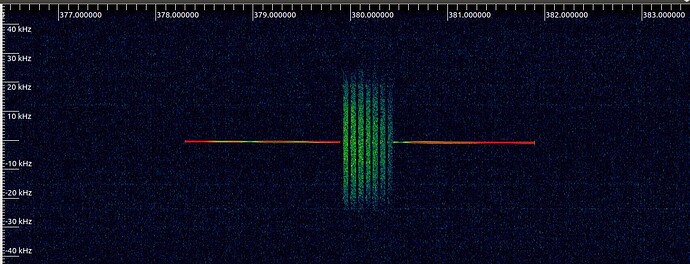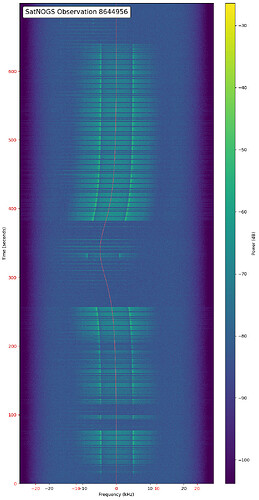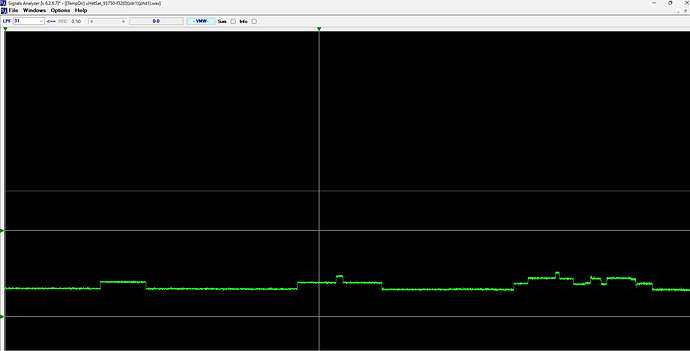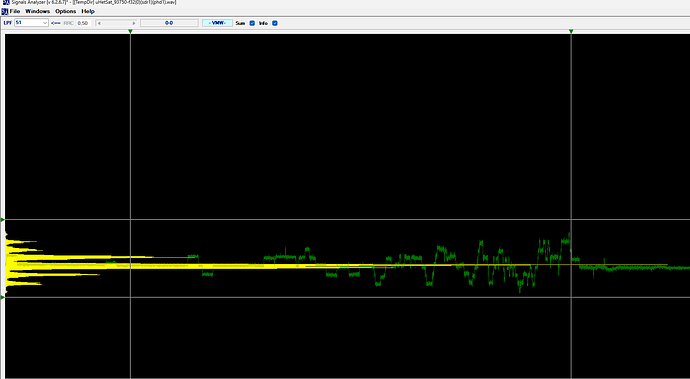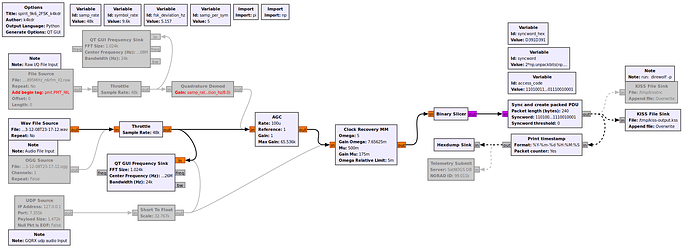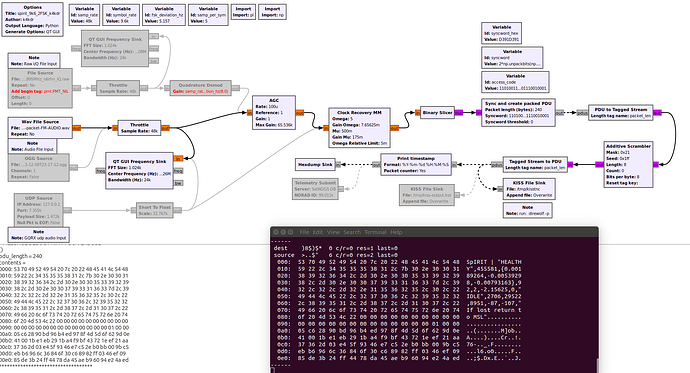K4KDR
December 4, 2023, 3:41am
62
Not having any luck determining the modulation & framing for this uHETSat on 401.500.
As you can see below, it’s a STRONG center carrier followed by a quick flash (just under 1/2 second) of data packets around 40k wide. Not matching up with any of the common modulation types, but I’ll keep trying!
2 Likes
PE0SAT
December 4, 2023, 5:38am
63
Hi Scott,
I am also trying to get some idea of the modulation used, at the moment I trying to find out what radio is onboard and go from there.
Jan PE0SAT
2 Likes
vk5qi
December 4, 2023, 5:47am
64
This observation has an interesting interferer: SatNOGS Network - Observation 8640718
It appears to be perfectly doppler corrected to the TLE in use (58467), but is a bit lower in frequency. SpIRIT’s beacons are also visible in the same observation.
EDIT: It appears to be ID 51832 - SatNOGS DB - OBJECT J - 2022-019
vk5qi
December 5, 2023, 12:51am
65
Looks like 58468 is the current best fit for SpIRIT:
2 Likes
deckbsd
December 5, 2023, 9:38am
66
Hello @K4KDR ,
Do you have a recording ? iq file ?
bcsak
December 5, 2023, 10:08am
67
Yeah, now it was set to 58472… and it looks good! Thanks!
2 Likes
K4KDR
December 5, 2023, 10:24am
68
Here is my best uHETSat packet from GQRX as a float-32 .RAW file w/ sample rate = 93750:
https://www.qsl.net/k/k4kdr//iq/uHETSat/
2 Likes
deckbsd
December 5, 2023, 11:24am
69
Thanks, could it be MFSK or PSK?
If a check your file in Signal Analyzer :
Here i’m converting this signal from IQ to real
And then if i open the phase detector, i have garbage all along the strong carrier :
and for the flash i get this :
which seems to be clearly data.
There are more or less 8 tones in data segments :
But i’m far from being an expert so i could be wrong
3 Likes
fredy
December 5, 2023, 12:49pm
70
Latest status update, still we have only 11 from 25 TLE sets, so we are keep watching before finalize identifications:
Temporary NORAD ID
Satellite
NORAD ID to follow
Other NORAD IDs
Identified
Deployed
Last Update
Notes
RECEIVED AND DEMODULATED
98968 ION SCV Daring Diego
58469
-
NO
YES
Received, continue to follow 58469
99320 EIRSAT-1
58472
58471(unlikely)
NO
YES
Received, changed to follow 58472, other possible 58471(unlikely), removed 58470
99011 SpIRIT
58468
58467(unlikely)
NO
YES
Received, demodulated by 3rd parties, changed to follow 58468, other possible 58467, removed 58466, 58470, 58471, 58472
98971 ENSO
58470
58471(unlikely)
NO
YES
Received, changed to follow 58470, other possible 58471(unlikely), removed 58468, 58472
99032 Hayasat
58471
58470, 58472(unlikely)
NO
YES
Received, changed to follow 58471, other possible 58470, 58472(unlikely), removed 58465, 58467, 58468,
RECEIVED
98969 uHETSat
58466
58465(unlikely), 58467(unlikely)
NO
YES
Received, continue to follow 58466, other possible 58465(unlikely), 58467(unlikely), removed 58468
NOT RECEIVED WITH FREQUENCY
98970 KOYOH
58465
all
NO
UNKNOWN
Randomly chosen to follow 58465, all the objects are possible candidates
3 Likes
deckbsd
December 6, 2023, 10:45am
71
Hello,
Any chance you had time regarding this ?
Dereckt
December 7, 2023, 3:56pm
72
yeah, I hope send you a link by tomorrow !
1 Like
N6RFM
December 8, 2023, 2:54am
73
Has anyone been successful decoding SpiRit? FM demodulated wav file here.
TKS es 73,
1 Like
PE0SAT
December 8, 2023, 6:07am
74
If possible, please share an IQ file, SpiRIT seems to be using BPSK
vk5qi
December 9, 2023, 2:25am
75
It’s using 9600 baud FSK. See here: SpIRIT Nanosatellite (#267) · Issues · librespacefoundation / SatNOGS Operations · GitLab
Note that they haven’t provided any details on CRCs, so frame validity checking will be a challenge.
2 Likes
N6RFM
December 9, 2023, 3:41am
76
1 Like
K4KDR
December 9, 2023, 5:00am
78
Does anyone know, or have a way to find out if this might be a valid SpiRIT frame?
------
000: ac 91 54 c8 a4 d1 13 58 ca 58 9a 7c 31 db 03 42 ..T....X.X.|1..B
010: 0d 5f 01 ec 58 38 8f b7 56 75 bc 92 91 04 fa 29 ._..X8..Vu.....)
020: 08 6a a1 e9 a6 c0 8a 25 a4 ec c4 b3 66 77 2a 18 .j.....%....fw*.
030: 78 e8 e9 e5 e8 a1 ba fa de e2 7f 3f 01 6a f3 ba x..........?.j..
040: cd dc 3c e1 db f0 37 23 40 0b db 29 94 fb 07 27 ..<...7#@..)...'
050: e3 fa 5a a9 94 2a ef f0 83 9a 4f e3 66 2f 57 3e ..Z..*....O.f/W>
060: b4 91 f0 5a 78 da fe 32 72 42 57 f2 1a 10 a0 32 ...Zx..2rBW....2
070: 69 04 c2 06 8c 3b b1 c6 81 0d d3 71 eb e5 cf b5 i....;.....q....
080: 10 58 ca 35 37 c3 0c 89 ba 9e 74 0e dc e5 95 02 .X.57.....t.....
090: 55 5f 0b 76 5b 83 ee e3 59 d6 b1 e8 2f 8c 32 06 U_.v[...Y.../.2.
0a0: c9 12 cc 27 99 6d dd 68 b5 b8 f0 3c fa 71 db 06 ...'.m.h...<.q..
0b0: 51 31 6a 54 9a 8d 79 57 80 0b 10 f0 d2 2a d6 4a Q1jT..yW.....*.J
0c0: 08 8a 6e b0 59 2f 15 02 ba 8a 14 b7 55 f2 d1 44 ..n.Y/......U..D
0d0: 41 19 93 d7 9b c5 98 c1 ea 62 da 0b 94 00 f6 0a A........b......
0e0: e3 b4 c9 7f 6d b9 cc 98 d4 35 67 d0 5e eb 69 e9 ....m....5g.^.i.
------
1 Like
deckbsd
December 9, 2023, 10:45am
79
It could be, the size are corresponding :
- Frame Length (excl. preamble and sync): 240 bytes
That said we don’t have decoder for it and it doesn’t seems to be AX25. But that said i think maybe the data needs to be PN9 decoded first.
K4KDR
December 9, 2023, 11:20am
80
Thanks for the reply.
While there is every chance that there’s room for improvement, here is a GNU Radio flowgraph that runs through the bitstream from:
-raw I/Q file
… and when the D391D391 syncword is found, outputs 240-byte frames. There was the one good frame (posted previously) from the I/Q shared by N6RFM and when I processed some of the .OGG files from strong-looking SatNogs observations, dozens (if not hundreds) of frames output. I was encouraged since these are not likely ‘trash’ decodes since the process depends on matching the syncword.
Please feel free to try it out and make improvements!
https://www.qsl.net/k/k4kdr//grc/spirit/
1 Like
K4KDR
December 9, 2023, 12:30pm
81
Very grateful to vk5qi for pointing out that the reason my Spirit output was just random HEX was because there was also a scrambler on the decoded output.
I’ve upgraded the GNU Radio flowgraph to include the additional step and as you can see below, the output now includes some readable ASCII
6 Likes
